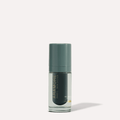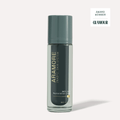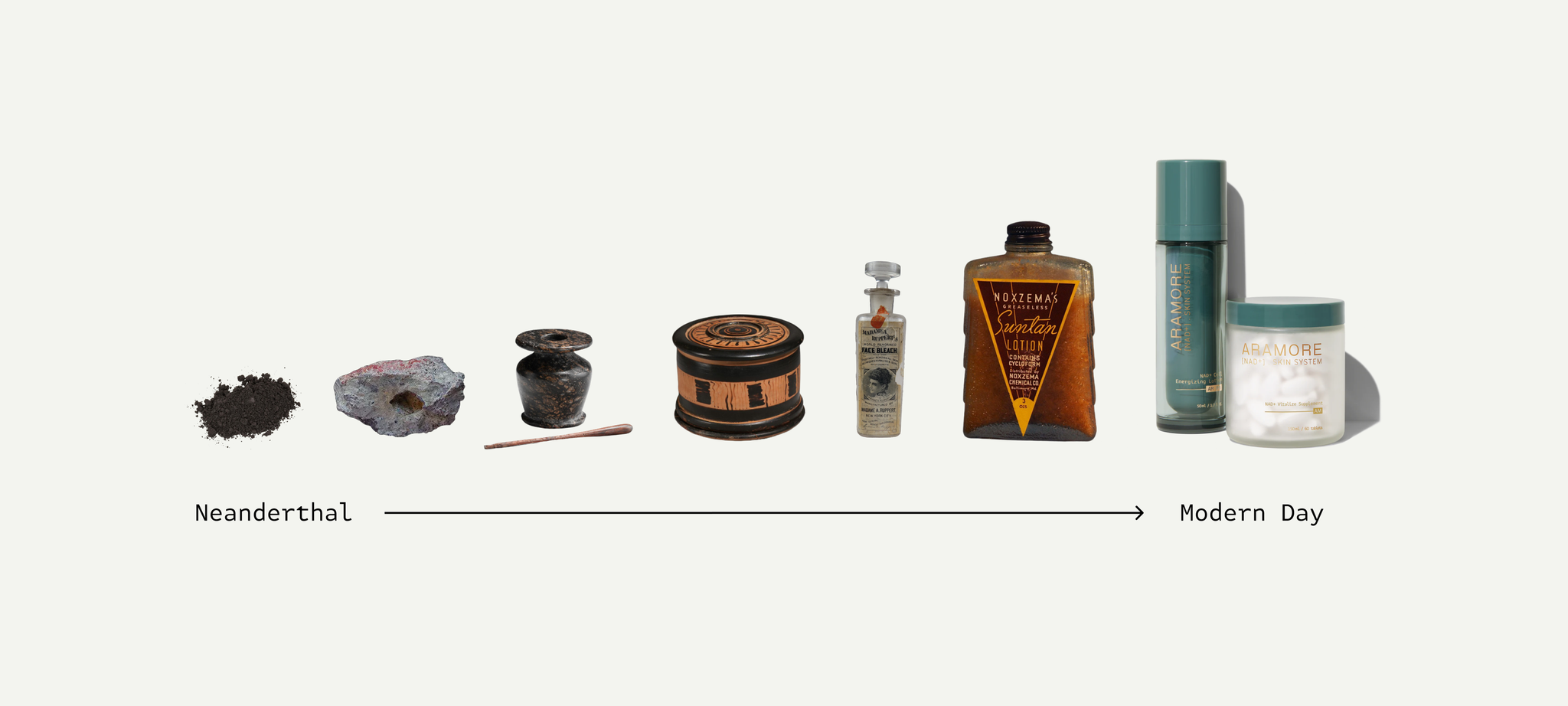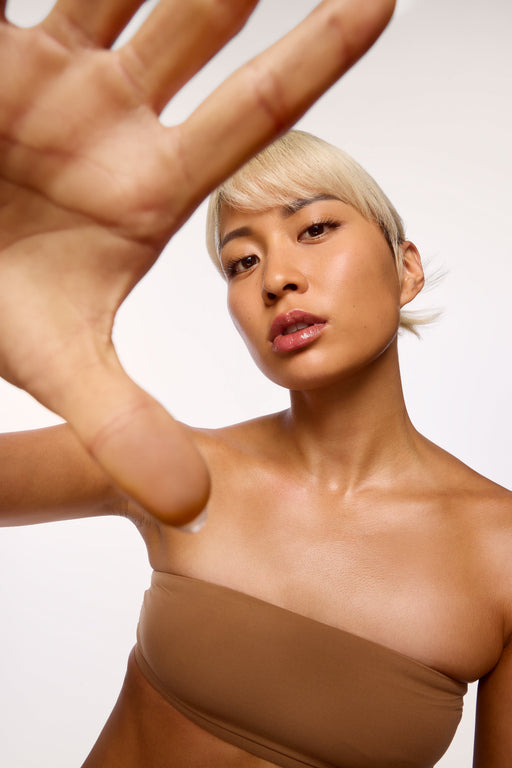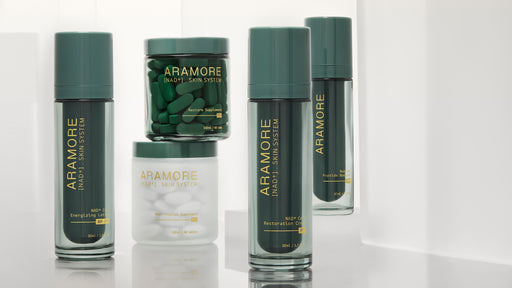By Dr. Carolyn Ayers, PhD
It was not enough for Aramore to assemble an expert scientific team from a variety of fields. To understand and advance skincare, we needed to know its history too. The story of skincare is long and fascinating, beginning tens of thousands of years ago with the Neanderthals, and culminating with our game-changing products today.
Neanderthals
Surprisingly, the history of skincare goes all the way back to the time of the Neanderthals, an extinct species of archaic humans who lived alongside modern humans until around 40,000 years ago. In 2008, archaeologists Francesco d’Errico and Marie Soressi found hundreds of crafted blocks of black manganese pigment from two sites in France. They speculate that the pigments, which would have drawn straight lines, were used on the Neanderthals’ pale skin. Red and yellow pigments found in oyster shells in Spain in 1985, and rediscovered in 2010, back up these claims. According to archaeologists, the pigments—composed of minerals like lepidocrocite, hematite, pyrite, goethite, and charcoal—were “darkly sparkling,” and resembled “makeup like the shimmery stuff that people were wearing a few years ago.”
Not only is the Neanderthals’ use of cosmetics interesting, but it is also actually evidence that they were smarter than we give them credit for. Neanderthals are often thought to have died out because they weren’t as smart as humans, but d’Errico says that decorating their faces and bodies with makeup and jewelry is proof that they were capable of symbolic communication, and maybe even language. Given early modern humans were trading colored pigments in Africa as far back as 300,000 years ago, it’s a distinct possibility. 
Ancient Egypt
Cosmetics were a part of Ancient Egypt from at least 4,000 BC. By the time of the Middle Kingdom (2030–1650 BC), wealthy Egyptian women were engaging in a robust beauty regimen—and before applying makeup, they took care of their skin. They exfoliated with salts from the Dead Sea, wore hydrating face masks made from milk and honey, maybe even bathed in milk, and used a mixture of olive oil, cypress, and milk to combat wrinkles. Milk is a common ingredient in skincare products to this day, and lactic acid has been shown to be an effective moisturizer. Olive oil, on the other hand, has been shown to reduce the appearance of stress-induced signs of aging. At Aramore, we took inspiration from ancient Egyptians—with a modern spin—by incorporating hydroxytyrosol (HXT) extracted from olive oil in our supplements. As the most potent antioxidant to be discovered in nature yet, HXT maintains skin health.
Only after taking care of their skin would the Egyptians apply eyeshadow, lipstick, and black kohl around their eyes. Kohl eyeliner, made from the mineral galena, was used by both sexes and wasn’t just for aesthetic purposes. It was also a practical way to protect the skin (and eyes) from the harsh desert sun. The same goes for the use of rouge, made from red ochre, to color the cheeks. Oils, creams, and ointments were also applied to repel insects and prevent infection.
Shang Dynasty
Galena is lead sulfide, and we know lead-based cosmetics have been used in China since ancient times. The use of songyi mushrooms in skincare products to promote new cell growth and rejuvenate skin can also be traced back to China’s Shang dynasty (2070–1600 BC). Originally sought out for their skin-lightening properties, the various components of mushrooms have been shown more recently to improve the appearance of facial wrinkles, and to have antioxidant, anti-aging, and moisturizing effects.
Ancient Greece and Rome
Ancient Egypt’s skincare practices spread to Greece and Rome. Cold cream was invented by the Greek doctor Galen in the second century. Designed to remove makeup and smooth the skin, cold cream in its original formulation was a mixture of water, beeswax, and olive oil.
Book III of Ovid’s The Art of Love implies that lanolin (“that oily juice which they extract from the fleece of sheep”) was a common beauty product for Roman women, despite its unpleasant odor, and research has shown that it is effective at hydrating the skin. Another work describes, amongst other things, a myrrh-based remedy for blackheads; myrrh is still considered an effective acne treatment today.
Elizabethan England
The Elizabethans were particularly fond of skin lightening. Venetian ceruse was a mix of water, vinegar, and white lead, and Queen Elizabeth was known to apply it to her face in extremely liberal amounts. Not only did using ceruse come with the risk of lead poisoning, applying it regularly also damaged the skin, leaving blemishes and scars the user would attempt to cover up by applying even more layers.
In Queen Elizabeth’s case, we know she used “a cleansing lotion made from two newly laid eggs and their shells.” Eggs are also recommended in an early medical text composed in medieval Italy and are now known to contain phospholipids, which are used in skincare products today for their ability to hydrate the skin and to prolong the release of other active ingredients.
20th Century
The patent medicines of the 1800s gave way, in the United States, to an explosion of branded skincare products. Tans became fashionable in the 1920s, and with them tanning oils. Unfortunately, the sun’s ultraviolet (UV) rays cause the skin to age, wrinkle and become less elastic, not to mention the possibility of melanoma. Sunscreens, therefore, became popular too, with the SPF rating system being introduced in the 1960s.
Early sunscreens with high SPF ratings did a good job of protecting skin from the sun’s UVB rays, but it wasn’t until the 1990s that they began guarding against UVA rays too. Attempts to turn back the effects of aging at the end of the century also included the use of lasers, chemical peels, microdermabrasion and other severe methods to improve skin longevity.
Our all-mineral, multi-defense sunscreen (launching soon) avoids the risk of endocrine disruption associated with some chemical sunscreens, while, of course, steering clear of some items the ancients used—like lead—that can be harmful even in trace amounts.
The Future
The star ingredient in our topical products, Nicotinamide mononucleotide, or NMN, is the precursor to nicotinamide adenine dinucleotide, NAD+.
Though first discovered by British biochemists Arthur Harden and William John Young in 1906, it wasn’t until 2020 that Harvard’s Dr. Anna Mandinova (a scientific co-founder here at Aramore) discovered how to use NAD+ and its cofactors to help replenish the skin.
NAD+ precursors, combined with other compounds to synergistic effect, promise to be a new frontier in anti-aging skincare.
Future Proof your Skin with the Skin NAD+ Discovery Set: SHOP LINK
